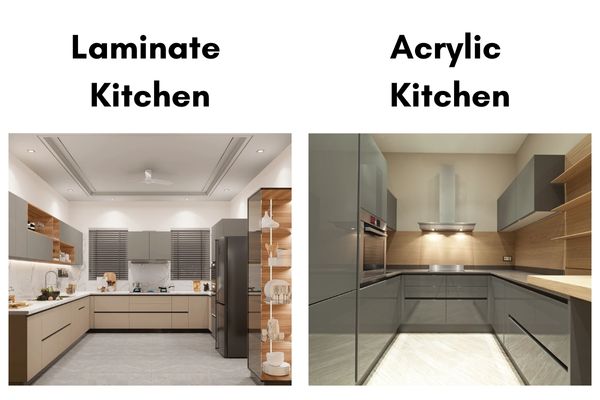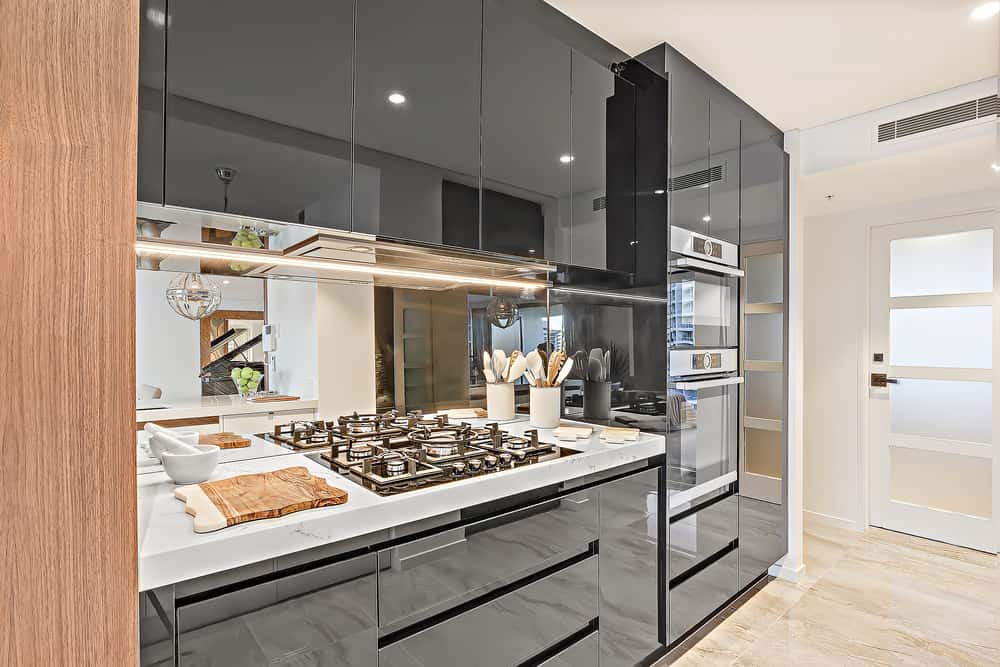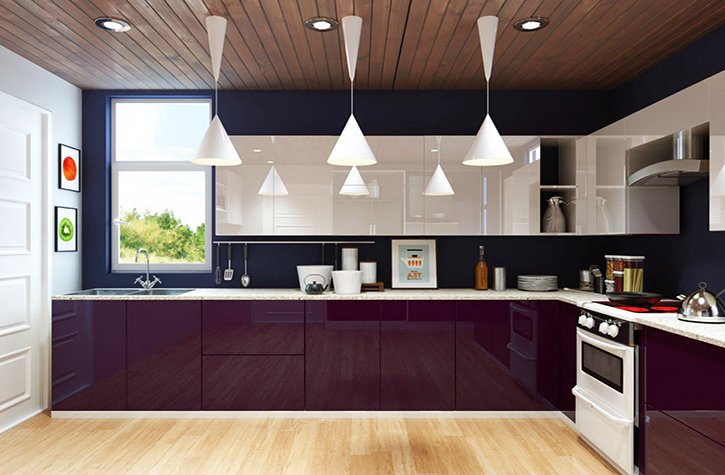
05
AprGlossy glamour or tough-as-nails practicality? When it comes to your dream modular kitchen in Gurgaon, the battle of acrylic vs laminate kitchen is real. Let's find out which finish reigns supreme for your home. At Urban Design Co., we know that choosing the right materials for your modular kitchen in Gurgaon can feel like a big decision. That's why we're here to break down the buzz around acrylic kitchen finishes and how they stack up against good old laminate. We want to make sure you get the best modular kitchen interior that perfectly matches your style and needs. Let's dive in and explore the world of kitchen finishes together!
What are Acrylic Finishes?

When we talk about an acrylic kitchen finish, we're referring to a high-gloss, non-toxic, plastic-based material that's applied as a top layer to a base material like MDF (Medium-Density Fiberboard). Think of it as a sleek, polished shield that gives your kitchen cabinets a vibrant and luxurious look. The manufacturing process involves bonding this acrylic sheet to the substrate with strong adhesives, creating a smooth, seamless surface. What's really cool about acrylic is its depth of color and the way it reflects light, instantly making your kitchen feel brighter and more spacious. Plus, the non-porous nature of acrylic makes it quite resistant to moisture and stains, which is a big win in a busy kitchen environment.
What are Laminate Finishes?

Laminate finishes, on the other hand, are created by pressing together thin layers of flat paper and resins. The top layer is usually a printed decorative sheet that can mimic the look of wood, stone, or even solid colors. This layered construction is then bonded to a core material, often particleboard or MDF, using heat and pressure. Laminates are known for their durability and versatility. They come in a wide array of textures, patterns, and colors, offering incredible design flexibility. While not as reflective as acrylic, advancements in manufacturing have led to the creation of high-gloss laminates that offer a similar aesthetic at a more budget-friendly price point. They are also quite resistant to scratches and wear and tear, making them a popular choice for many homeowners.
Major Differences in Laminate vs. Acrylic Kitchen Finishes
-
Appearance and Aesthetics:
- Acrylic: Known for its exceptionally high-gloss finish, providing a smooth, mirror-like surface. The colors tend to be richer and more vibrant, offering a sense of depth and luxury. The reflective quality of acrylic can also enhance the brightness and perceived spaciousness of your kitchen.
- Laminate: Offers a wide spectrum of finishes, from matte and textured to high-gloss options. While high-gloss laminates are available, they generally don't achieve the same level of deep sheen as acrylic. Laminates excel in replicating the look and feel of natural materials like wood and stone, thanks to advanced printing technology.
- Acrylic: Known for its exceptionally high-gloss finish, providing a smooth, mirror-like surface. The colors tend to be richer and more vibrant, offering a sense of depth and luxury. The reflective quality of acrylic can also enhance the brightness and perceived spaciousness of your kitchen.
-
Durability and Resistance:
- Acrylic: Generally exhibits superior resistance to scratches and scuffs compared to standard laminates. It also boasts excellent resistance to UV rays, which helps prevent color fading over prolonged exposure to sunlight. Being non-porous, acrylic is highly resistant to moisture and stains, making it a practical choice for the kitchen environment.
- Laminate: Offers good overall durability and is resistant to everyday wear and tear. It can withstand moderate impacts and is also moisture-resistant, especially higher-quality variants. However, its scratch resistance might not be as high as acrylic, and prolonged exposure to direct sunlight could potentially lead to slight fading over many years. The edges of laminate can also be more susceptible to chipping if not properly handled or finished.
- Acrylic: Generally exhibits superior resistance to scratches and scuffs compared to standard laminates. It also boasts excellent resistance to UV rays, which helps prevent color fading over prolonged exposure to sunlight. Being non-porous, acrylic is highly resistant to moisture and stains, making it a practical choice for the kitchen environment.
-
Cost Factor:
- Acrylic: Typically falls into a higher price bracket compared to laminate finishes. The premium look, enhanced durability, and specialized manufacturing processes contribute to its higher cost.
- Laminate: Generally a more budget-friendly option, making it accessible to a wider range of homeowners. It provides a good balance of durability and aesthetics without the higher investment associated with acrylic.
- Acrylic: Typically falls into a higher price bracket compared to laminate finishes. The premium look, enhanced durability, and specialized manufacturing processes contribute to its higher cost.
-
Maintenance and Cleaning:
- Acrylic: It easy to clean with a soft cloth and mild detergent due to its smooth, non-porous surface. However, the high-gloss nature means that fingerprints, smudges, and watermarks might be more noticeable and require more frequent wiping to maintain a pristine look.
- Laminate: Also easy to clean with similar methods. Its surface, especially matte or textured varieties, tends to conceal fingerprints and smudges more effectively than high-gloss acrylic.
- Acrylic: It easy to clean with a soft cloth and mild detergent due to its smooth, non-porous surface. However, the high-gloss nature means that fingerprints, smudges, and watermarks might be more noticeable and require more frequent wiping to maintain a pristine look.
-
Variety and Design Flexibility:
- Acrylic: While offering rich colors, the range of textures and patterns is generally more limited compared to laminate, often focusing on solid, high-gloss shades.
- Laminate: Provides an extensive array of colors, patterns, and textures. You can find laminates that mimic wood grains, stone finishes, metallic looks, and various solid colors, offering greater design versatility to match diverse kitchen styles.
- Acrylic: While offering rich colors, the range of textures and patterns is generally more limited compared to laminate, often focusing on solid, high-gloss shades.
-
Repair and Longevity:
- Acrylic: Minor surface scratches can sometimes be buffed out or repaired using specialized products. With proper care, acrylic finishes can maintain their luxurious appearance for a long time.
- Laminate: Repairing damage like chips or deep scratches is generally more challenging, and often the entire cabinet panel may need replacement. However, with good maintenance, high-quality laminates can also offer excellent longevity.
- Acrylic: Minor surface scratches can sometimes be buffed out or repaired using specialized products. With proper care, acrylic finishes can maintain their luxurious appearance for a long time.
Which is Better? Laminate or Acrylic Kitchen? Urban Design Co. Helps You Decide
Choosing between laminate and an acrylic kitchen ultimately boils down to your personal preferences, budget, and lifestyle.
So, which one is better for you?
- Go for Acrylic if: You desire a super glossy, high-end look and are willing to invest a bit more for enhanced scratch resistance and a vibrant finish. If making a bold style statement is your priority, an acrylic kitchen could be your perfect match.
- Opt for Laminate if: You're looking for a durable, versatile, and budget-friendly option with a wide array of design choices. If practicality and getting the most bang for your money are key, laminate is a fantastic choice.
At Urban Design Co., your trusted modular kitchen manufacturer in Gurgaon, we believe your kitchen should be a reflection of your unique taste and lifestyle. Our expert designers can walk you through the options, show you samples, and help you visualize how each finish will look in your space. With Urban Design Co., you can be sure that you'll get the best modular kitchen interior in town, perfectly customized to your needs. Let us help you design the modular kitchen of your dreams.
Conclusion
Deciding between an acrylic kitchen and a laminate finish is a crucial step in designing your dream modular kitchen. Both materials offer distinct advantages in terms of aesthetics, durability, and cost. By understanding these differences and considering your own priorities, you can make an informed decision that you'll be happy with for years to come. And remember, Urban Design Co. in Gurgaon is always here to guide you through the process and ensure you get the perfect modular kitchen interior.
FAQs
Q1. Are acrylic finishes prone to chipping?
While acrylic is quite durable, very sharp impacts could potentially cause chipping. However, with normal use, it holds up very well.
Q2. Can laminate finishes fade over time?
High-quality laminates are generally resistant to fading, but prolonged exposure to direct sunlight might cause slight discoloration over many years.
Q3. Which one is easier to repair than the other in laminate vs acrylic?
Minor scratches on acrylic can sometimes be buffed out. Laminate damage is generally harder to repair seamlessly, and often the entire panel needs replacement.
Q4. Do acrylic kitchens look very modern?
The high-gloss nature of acrylic often lends itself to modern and contemporary designs, but color choices and overall kitchen design can influence the final look.
Q5. Are there eco-friendly options for either material?
Yes, manufacturers are increasingly offering eco-friendly options for both acrylic (using recycled materials) and laminate (using sustainably sourced wood cores and low-VOC adhesives).


